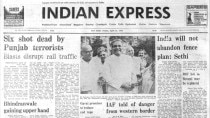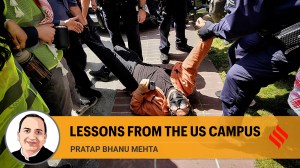- India
- International
The Kuwait model
Despite growing Sunni resentment, the country is still a role model for integrating the Shia population.
 Kuwait has the largest proportion of the Shia — 35 per cent — in the Gulf Arab states after Bahrain, but presents a contrast to the oppressive manner in which Saudi Arabia and Bahrain have tackled their Shia populations.
Kuwait has the largest proportion of the Shia — 35 per cent — in the Gulf Arab states after Bahrain, but presents a contrast to the oppressive manner in which Saudi Arabia and Bahrain have tackled their Shia populations.
The 21st century must be rated the most bizarre time for Muslims of the world. From the beginning of the last century, when reformers dominated their civil societies under secular dictators, to the end of it, when they reached back to a more “original” or “pure” Islam while aspiring to democracy, they have seemed to embrace an internecine frenzy. A sliding back to “pure” Islam has inevitably become sectarian between the Sunni majority and the Shia minority, to say nothing of the other deviant sects that get trampled as the big sects brawl.
The Gulf has seeds of a terrible fratricide in its guts as the “hidden” Shia minorities become assertive because of Islam’s retreat into “purity”: Pan-Arabism that hid “the schism of centuries” has yielded ground and one “pan” movement has been replaced by another “pan” movement. Dictators bound the Arab nations together on the basis of race; democracy-driven Islam has hacked them apart.
There is evidence that Muslims go nuts after embracing democracy. Equipped with rights formerly restricted by dictators, they first change their democratic institutions, asserting that Islam is nothing if not democratic. Once done with the “correction” of democracy through constitutional amendments, they turn to Islam and whittle it down to its sectarian kernel, deeming its humanising accretions as “sinful innovations”.
The case of Kuwait is particularly noteworthy. Kuwait had a population of 2.5 million (in 2006) out of which only 45 per cent were Kuwaiti Arabs. There were 35 per cent Arabs of other origins, 9 per cent South Asians and 4 per cent Iranians. Kuwait has the largest proportion of the Shia — 35 per cent — in the Gulf Arab states after Bahrain, but presents a contrast to the oppressive manner in which Saudi Arabia and Bahrain have tackled their Shia populations. The Shia of Kuwait, mostly migrants from Saudi Arabia, Bahrain and Iran, are the best integrated population living among Sunni Arabs, and this is owed to the ruling al-Sabah family.
There is evidence that the increasingly conservative merchant class of Sunni Kuwaitis did not always agree with al-Sabah’s policy, which they saw as using the Shia to water down Sunni strength in the country. There is evidence, too,
that funds were made available from Kuwait’s private sector to terrorists willing to attack the Shia in Pakistan and Iran.

In fact, the al-Qaeda man who planned America’s 9/11 was from Kuwait. But the al-Sabah policy has succeeded so
well that Kuwait’s Shia policy might become a model for other Sunni states in the region.
Proof of the soundness of this policy came when Saddam Hussein invaded Kuwait in 1990 and saw that the Shia were the backbone of the Kuwaiti resistance to the Iraqi occupation, refusing to give up against impossible odds while the al-Sabah family fled to Saudi Arabia. When the ruler, Jabir al-Sabah, returned to Kuwait after the Gulf War, the Shia reaffirmed their allegiance to him, viewing him as a symbol of national unity.
The Shia community has played an important role in Kuwait’s economy.
Its members are effective in parliament and hold key police and army posts.
One can say that the Shia of Kuwait feel proud of being Kuwaitis in contrast to the Shia of Saudi Arabia — where they
demand civic rights in return for loyalty — and Bahrain. That this is due to the “undemocratic” intervention of the “pluralist” amir is quite evident from the occasional angry reaction from the Kuwaiti Sunni clergy and an increasingly conservative population.
Sunni Kuwaitis resent the official policy of tolerance. A Shia visitor to Kuwait in 1985 from southern Lebanon, author Fouad Ajami, aroused hostility among the local intellectuals who saw his Shia faith in a negative light. The occasion
was a conference in which Ajami read a report approving the teaching of political science in English in Kuwait. One Kuwaiti writer named Baghdadi levelled severe criticism at the organisers for having invited a “shu’ubi” (outsider).
In 1983, there was the suicide bombing of the American embassy in while other places like the country’s big
oil refinery were also unsuccessfully targeted. The terrorists had turned out to be Iran-inspired Shias. In 1981, out of
the 72 Shia men arrested in Bahrain for trying to blow up important sites, there were some Kuwaiti nationals too.
Some Shia reaction was a response to the “tightening” of the identity of the Sunni Arabs in Kuwait.
Democracy triggered 9/11. It was the intensifying religious reaction of the Kuwaiti merchant class that produced the two half-Pakistanis with Kuwaiti blood, Khalid Sheikh Mohammed and Ramzi Yousef. Yousef first took on Iran and indulged in sectarian violence before joining al-Qaeda in Pakistan. He caused a bomb blast in the holy shrine of Mashhad, Iran, that killed 24 in 1994. Later, Khalid was able to collect funds from rich Kuwaiti merchants for al-Qaeda and became the plotter of the destruction of the World Trade Centre and the attack on the Pentagon
on September 9, 2001.
EXPRESS OPINION
Must Read
More Explained
Apr 27: Latest News
- 01
- 02
- 03
- 04
- 05











































